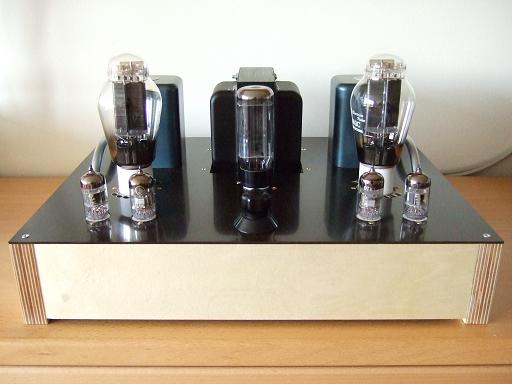D.I.Y Aikido driven 2A3 SE Amplifier
About 6 weeks after having build the Aikido driven EL84 SE, 2A3 SE amplifier was ready. Given the time constraints I have to persue this hobby, this very short period of time is a proof of my fondness for the Aikido circuit and also of my strong desire to hear the result of the combination of the Aikido and the 2A3 directly heated triode. Instead of building a complete new amp, I took appart my former 2A3 SE amplifier and re-used the power supply block.
Appart from the new Aikido driver circuit, there are some other minor changes in the power supply. The multiturn pots to adjust the bias of the 2A3 are 50K instead of 100K. With the new value the required DC grid resistance specified for this tube when used in fixed bias mode is kept. The former 100K value never gave me any trouble yet with 50K thermal runnaway should be avoided for sure.
Another slight change is the use of two 68uF/400V capacitors instead of one 100uF/450V in the power supply filter. Mainly because I prefer two smaller caps in parallel than a large single one. The ESR (equivalent series resistance) is about half the value and I guess sonically this may also be advantageous.
Finally the resistors in the heater supply for the driver tubes were removed. They are not necessary now with 4 tubes drawing enough current, the heater voltage settles at 6.6V.
The Hammond AX302 power transformer does get a little hot after a couple of hours of operation, but it is quiet and with all those center tapped windings it makes life easier in many ways.
Is the effort of a further tube worth it?
DEFINITELY!
The sound of the amplifier is clear, very detailed yet smooth, authentic and sovereign. From what I have tried for driving a 2A3, the Aikido driver delivers the finest tone. Hum? Dead quiet!
Changing tubes makes a clear a difference. From the three pairs of 2A3 I have (Sovtek, EH-Gold and 2A3C from Shuguang), the 2A3C is my preferred one. The Aikido first stage uses a 6N2P which is similar to the ECC83 or 12AX7 but with the heater pins being 4 and 5. This tube has a shield between the two triodes (pin 9) that can be put to good use. In the second stage dwells a 6N1P. I think I prefer this one over the EH 6AQ8 it had fitted before. In the EL84 SE Aikido amplifier it was the other way around.
A very nice feature of the Aikido circuit is the possibility (within a range) to change tubes without having to change anything else. Check out John Broskie's article about the Aikido. and his proposals on Aikido Power Amplifiers .
Find some more Aikido related links on the Aikido driven EL84 amplifier page.
System: ROTEL RCD-1072 as transport with DACMagic, 2A3 SE amplifier and B&W 703 speakers.
Yet with a portable CD player and self made single driver backloaded horns (the speakers at my workshop) the results are also VERY pleasant.
The effect of changing the power supply choke on the sound
With the power supply depicted in the schematic, using the 2A3C with the Tamura OPTs, the plate voltage settles at about 245V with the plate current set to 48mA.I wanted to check what impact it would have if the original choke -the Hammond 157Q (3.5H@150mA)- was replaced by the larger Hammond 193H (5H@200mA). To my surprise this had a very noticeable effect on the sound. Specifically the bass register suffered a considerable loss in perceived strenght. After a day-long-listening I decided to change back to the previous state.
With the 5H choke the +B went up 10 volts, really a minor change. The effect on the operating points is not even worth mentioning, the loss in bass cannot be attributed to it. Since the audio signal has to pass through the power supply, the change in the L-C combination in this part of the circuit is very likely the root cause. The bigger choke has modified the power supply source impedance probably creating a resonance point somewhere in the low frequency range. The importance of a good power supply cannot be stressed enough, but what is the secret of a good power supply? The aim to achieve a low and flat impedance over the entire frequency range is surely one factor.
Keeping the 3.5H choke and adding 200nF to the first capacitor in the power supply totalling to 3uF, yields nearly the same increase in +B (about 8V) yet without the change in bass response experienced with the choke exchange. This way the 2A3C plate dissipates: 250V x 48mA.